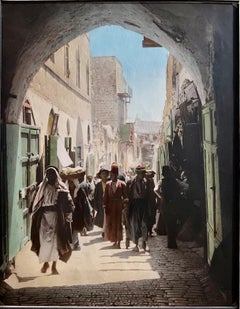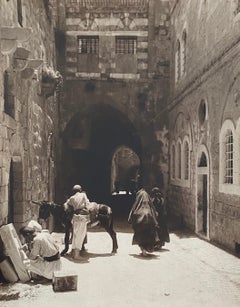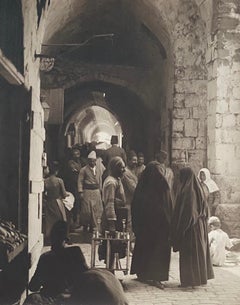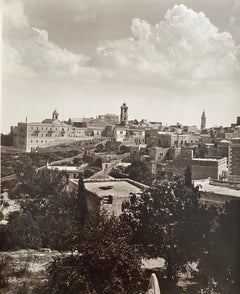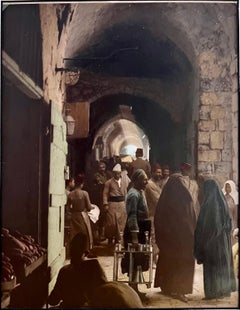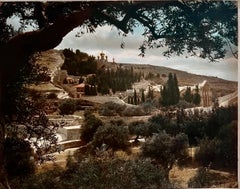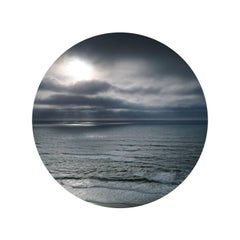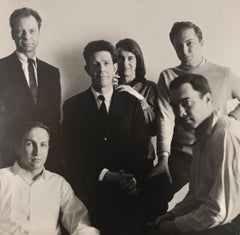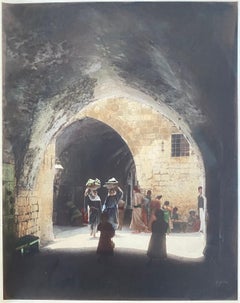American Colony Jerusalem Art
to
3
4
Overall Width
to
Overall Height
to
3
4
7
3
3
2
2
1
1
1
1
1
1
1
1
1
1
1
1
1
1
7
7
7
8,779
2,809
1,642
1,313
7
Artist: American Colony Jerusalem
Vintage Large Albumen Photo Jerusalem Photograph American Colony Old City Market
By American Colony Jerusalem
Located in Surfside, FL
The mat measures 21 X 16 the images are around 12 X 9 inches. They bear the blindstamp of the American Colony Jerusalem.
I am not sure if these are hand colored but they are from the period. Old City Shuk or Souq.
The Original American Colony was a colony established in Jerusalem in 1881 by members of a utopian society led by Anna and Horatio Spafford. Now a hotel in East Jerusalem, it is still known by that name today.
After suffering a series tragic losses following the Great Chicago Fire of 1871 (see hymn "It is Well with My Soul"), Chicago residents Anna and Horatio Spafford led a small American contingent in 1881 to Jerusalem to form a utopian society. The "American Colony," as it became known, was later joined by Swedish Christians. The society engaged in philanthropic work amongst the people of Jerusalem regardless of religious affiliation, gaining the trust of the local Muslim, Jewish, and Christian communities.During and immediately after World War I, the American Colony carried out philanthropic work to alleviate the suffering of the local inhabitants, opening soup kitchens, hospitals, orphanages and other charitable ventures.
Towards the end of the 1950s, the society's communal residence was converted into the American Colony Hotel. The hotel is an integral part of the Jerusalem landscape where members of all communities in Jerusalem still meet. In 1992 representatives from the Palestine Liberation Organization and Israel met in the hotel where they began talks that led to the historic 1993 Oslo Peace Accord.
Panorama of Jerusalem, c. 1890-1920
The Colony moved to the large house of a wealthy Arab landowner, Rabbah Husseini, outside the city walls in Sheikh Jarrah on the road to Nablus. Part of the building was used as a hostel for visitors from Europe and America. A small farm developed with animals, a butchery, a dairy, a bakery, a carpenter's shop, and a smithy. The economy was supplemented by a shop selling photographs, craft items and archaeological artifacts. The American Colonists were embraced by the Jewish and Palestinian communities for their good works, among them, teaching in both Muslim and Jewish schools.
Photography
Around 1900, Elijah Meyers, a member of the American Colony, began taking photographs of places and events in and around the city of Jerusalem. Meyers's work eventually expanded into a full-fledged photographic division within the Colony, including Hol Lars (Lewis) Larsson and G. Eric Matson, who later renamed the effort as the Matson Photographic Service. Their interest in archeological artifacts (such as the Lion Tower in Tripoli pictured here), and the detail of their photographs, led to widespread interest in their work by archeologists. The collection was later donated to the Library of Congress.
World War I
When the Ottoman Empire entered World War I as an ally of Germany in November 1914, Jerusalem and Palestine became a battleground between the Allied and the Central powers. The Allied forces from Egypt, under the leadership of the British, engaged the German, Austrian and Turkish forces in fierce battles for control of Palestine. During this time the American Colony assumed a more crucial role in supporting the local populace through the deprivations and hardships of the war. Because the Turkish military...
Category
Early 20th Century Academic American Colony Jerusalem Art
Materials
Photographic Paper
Vintage Large Albumen Photo Jerusalem - House Of The "Rich Man"
By American Colony Jerusalem
Located in Surfside, FL
The Original American Colony was a colony established in Jerusalem in 1881 by members of a utopian society led by Anna and Horatio Spafford. Now a hotel in East Jerusalem, it is still known by that name today.
After suffering a series tragic losses following the Great Chicago Fire of 1871 (see hymn "It is Well with My Soul"), Chicago residents Anna and Horatio Spafford led a small American contingent in 1881 to Jerusalem to form a utopian society. The "American Colony," as it became known, was later joined by Swedish Christians. The society engaged in philanthropic work amongst the people of Jerusalem regardless of religious affiliation, gaining the trust of the local Muslim, Jewish, and Christian communities.During and immediately after World War I, the American Colony carried out philanthropic work to alleviate the suffering of the local inhabitants, opening soup kitchens, hospitals, orphanages and other charitable ventures.
Towards the end of the 1950s, the society's communal residence was converted into the American Colony Hotel. The hotel is an integral part of the Jerusalem landscape where members of all communities in Jerusalem still meet. In 1992 representatives from the Palestine Liberation Organization and Israel met in the hotel where they began talks that led to the historic 1993 Oslo Peace Accord.
Panorama of Jerusalem, c. 1890-1920
The Colony moved to the large house of a wealthy Arab landowner, Rabbah Husseini, outside the city walls in Sheikh Jarrah on the road to Nablus. Part of the building was used as a hostel for visitors from Europe and America. A small farm developed with animals, a butchery, a dairy, a bakery, a carpenter's shop, and a smithy. The economy was supplemented by a shop selling photographs, craft items and archaeological artifacts. The American Colonists were embraced by the Jewish and Palestinian communities for their good works, among them, teaching in both Muslim and Jewish schools.
Photography
Around 1900, Elijah Meyers, a member of the American Colony, began taking photographs of places and events in and around the city of Jerusalem. Meyers's work eventually expanded into a full-fledged photographic division within the Colony, including Hol Lars (Lewis) Larsson and G. Eric Matson, who later renamed the effort as the Matson Photographic Service. Their interest in archeological artifacts (such as the Lion Tower in Tripoli pictured here), and the detail of their photographs, led to widespread interest in their work by archeologists. The collection was later donated to the Library of Congress.
World War I
When the Ottoman Empire entered World War I as an ally of Germany in November 1914, Jerusalem and Palestine became a battleground between the Allied and the Central powers...
Category
Late 19th Century Academic American Colony Jerusalem Art
Materials
Photographic Paper
Vintage Large Albumen Photo - Via Dolorosa In Station Of The Bross. Jerusalem
By American Colony Jerusalem
Located in Surfside, FL
The Original American Colony was a colony established in Jerusalem in 1881 by members of a utopian society led by Anna and Horatio Spafford. Now a hotel in East Jerusalem, it is still known by that name today.
After suffering a series tragic losses following the Great Chicago Fire of 1871 (see hymn "It is Well with My Soul"), Chicago residents Anna and Horatio Spafford led a small American contingent in 1881 to Jerusalem to form a utopian society. The "American Colony," as it became known, was later joined by Swedish Christians. The society engaged in philanthropic work amongst the people of Jerusalem regardless of religious affiliation, gaining the trust of the local Muslim, Jewish, and Christian communities.During and immediately after World War I, the American Colony carried out philanthropic work to alleviate the suffering of the local inhabitants, opening soup kitchens, hospitals, orphanages and other charitable ventures.
Towards the end of the 1950s, the society's communal residence was converted into the American Colony Hotel. The hotel is an integral part of the Jerusalem landscape where members of all communities in Jerusalem still meet. In 1992 representatives from the Palestine Liberation Organization and Israel met in the hotel where they began talks that led to the historic 1993 Oslo Peace Accord.
Panorama of Jerusalem, c. 1890-1920
The Colony moved to the large house of a wealthy Arab landowner, Rabbah Husseini, outside the city walls in Sheikh Jarrah on the road to Nablus. Part of the building was used as a hostel for visitors from Europe and America. A small farm developed with animals, a butchery, a dairy, a bakery, a carpenter's shop, and a smithy. The economy was supplemented by a shop selling photographs, craft items and archaeological artifacts. The American Colonists were embraced by the Jewish and Palestinian communities for their good works, among them, teaching in both Muslim and Jewish schools.
Photography
Around 1900, Elijah Meyers, a member of the American Colony, began taking photographs of places and events in and around the city of Jerusalem. Meyers's work eventually expanded into a full-fledged photographic division within the Colony, including Hol Lars (Lewis) Larsson and G. Eric Matson, who later renamed the effort as the Matson Photographic Service. Their interest in archeological artifacts (such as the Lion Tower in Tripoli pictured here), and the detail of their photographs, led to widespread interest in their work by archeologists. The collection was later donated to the Library of Congress.
World War I
When the Ottoman Empire entered World War I as an ally of Germany in November 1914, Jerusalem and Palestine became a battleground between the Allied and the Central powers...
Category
Late 19th Century Academic American Colony Jerusalem Art
Materials
Photographic Paper
Vintage Large Albumen Photo Jerusalem Landscape
By American Colony Jerusalem
Located in Surfside, FL
The Original American Colony was a colony established in Jerusalem in 1881 by members of a utopian society led by Anna and Horatio Spafford. Now a hotel in East Jerusalem, it is still known by that name today.
After suffering a series tragic losses following the Great Chicago Fire of 1871 (see hymn "It is Well with My Soul"), Chicago residents Anna and Horatio Spafford led a small American contingent in 1881 to Jerusalem to form a utopian society. The "American Colony," as it became known, was later joined by Swedish Christians. The society engaged in philanthropic work amongst the people of Jerusalem regardless of religious affiliation, gaining the trust of the local Muslim, Jewish, and Christian communities.During and immediately after World War I, the American Colony carried out philanthropic work to alleviate the suffering of the local inhabitants, opening soup kitchens, hospitals, orphanages and other charitable ventures.
Towards the end of the 1950s, the society's communal residence was converted into the American Colony Hotel. The hotel is an integral part of the Jerusalem landscape where members of all communities in Jerusalem still meet. In 1992 representatives from the Palestine Liberation Organization and Israel met in the hotel where they began talks that led to the historic 1993 Oslo Peace Accord.
Panorama of Jerusalem, c. 1890-1920
The Colony moved to the large house of a wealthy Arab landowner, Rabbah Husseini, outside the city walls in Sheikh Jarrah on the road to Nablus. Part of the building was used as a hostel for visitors from Europe and America. A small farm developed with animals, a butchery, a dairy, a bakery, a carpenter's shop, and a smithy. The economy was supplemented by a shop selling photographs, craft items and archaeological artifacts. The American Colonists were embraced by the Jewish and Palestinian communities for their good works, among them, teaching in both Muslim and Jewish schools.
Photography
Around 1900, Elijah Meyers, a member of the American Colony, began taking photographs of places and events in and around the city of Jerusalem. Meyers's work eventually expanded into a full-fledged photographic division within the Colony, including Hol Lars (Lewis) Larsson and G. Eric Matson, who later renamed the effort as the Matson Photographic Service. Their interest in archeological artifacts (such as the Lion Tower in Tripoli pictured here), and the detail of their photographs, led to widespread interest in their work by archeologists. The collection was later donated to the Library of Congress.
World War I
When the Ottoman Empire entered World War I as an ally of Germany in November 1914, Jerusalem and Palestine became a battleground between the Allied and the Central powers...
Category
Late 19th Century Academic American Colony Jerusalem Art
Materials
Photographic Paper
Vintage Large Albumen Photo Jerusalem Photograph American Colony Old City Market
By American Colony Jerusalem
Located in Surfside, FL
The mat measures 21 X 16 the images are around 12 X 9 inches. They bear the blindstamp of the American Colony Jerusalem.
I am not sure if these are hand colored but they are from the period.
The Original American Colony was a colony established in Jerusalem in 1881 by members of a utopian society led by Anna and Horatio Spafford. Now a hotel in East Jerusalem, it is still known by that name today.
After suffering a series tragic losses following the Great Chicago Fire of 1871 (see hymn "It is Well with My Soul"), Chicago residents Anna and Horatio Spafford led a small American contingent in 1881 to Jerusalem to form a utopian society. The "American Colony," as it became known, was later joined by Swedish Christians. The society engaged in philanthropic work amongst the people of Jerusalem regardless of religious affiliation, gaining the trust of the local Muslim, Jewish, and Christian communities.During and immediately after World War I, the American Colony carried out philanthropic work to alleviate the suffering of the local inhabitants, opening soup kitchens, hospitals, orphanages and other charitable ventures.
Towards the end of the 1950s, the society's communal residence was converted into the American Colony Hotel. The hotel is an integral part of the Jerusalem landscape where members of all communities in Jerusalem still meet. In 1992 representatives from the Palestine Liberation Organization and Israel met in the hotel where they began talks that led to the historic 1993 Oslo Peace Accord.
Panorama of Jerusalem, c. 1890-1920
The Colony moved to the large house of a wealthy Arab landowner, Rabbah Husseini, outside the city walls in Sheikh Jarrah on the road to Nablus. Part of the building was used as a hostel for visitors from Europe and America. A small farm developed with animals, a butchery, a dairy, a bakery, a carpenter's shop, and a smithy. The economy was supplemented by a shop selling photographs, craft items and archaeological artifacts. The American Colonists were embraced by the Jewish and Palestinian communities for their good works, among them, teaching in both Muslim and Jewish schools.
Photography
Around 1900, Elijah Meyers, a member of the American Colony, began taking photographs of places and events in and around the city of Jerusalem. Meyers's work eventually expanded into a full-fledged photographic division within the Colony, including Hol Lars (Lewis) Larsson and G. Eric Matson, who later renamed the effort as the Matson Photographic Service. Their interest in archeological artifacts (such as the Lion Tower in Tripoli pictured here), and the detail of their photographs, led to widespread interest in their work by archeologists. The collection was later donated to the Library of Congress.
World War I
When the Ottoman Empire entered World War I as an ally of Germany in November 1914, Jerusalem and Palestine became a battleground between the Allied and the Central powers. The Allied forces from Egypt, under the leadership of the British, engaged the German, Austrian and Turkish forces in fierce battles for control of Palestine. During this time the American Colony assumed a more crucial role in supporting the local populace through the deprivations and hardships of the war. Because the Turkish military...
Category
Early 20th Century Academic American Colony Jerusalem Art
Materials
Photographic Paper
Vintage Large Albumen Photo Jerusalem Photograph American Colony Mt Zion Trees
By American Colony Jerusalem
Located in Surfside, FL
The mat measures 21 X 16 the images are around 12 X 9 inches. They bear the blindstamp of the American Colony Jerusalem.
I am not sure if these are hand colored but they are from the period. Old City Shuk or Souq.
The Original American Colony was a colony established in Jerusalem in 1881 by members of a utopian society led by Anna and Horatio Spafford. Now a hotel in East Jerusalem, it is still known by that name today.
After suffering a series tragic losses following the Great Chicago Fire of 1871 (see hymn "It is Well with My Soul"), Chicago residents Anna and Horatio Spafford led a small American contingent in 1881 to Jerusalem to form a utopian society. The "American Colony," as it became known, was later joined by Swedish Christians. The society engaged in philanthropic work amongst the people of Jerusalem regardless of religious affiliation, gaining the trust of the local Muslim, Jewish, and Christian communities.During and immediately after World War I, the American Colony carried out philanthropic work to alleviate the suffering of the local inhabitants, opening soup kitchens, hospitals, orphanages and other charitable ventures.
Towards the end of the 1950s, the society's communal residence was converted into the American Colony Hotel. The hotel is an integral part of the Jerusalem landscape where members of all communities in Jerusalem still meet. In 1992 representatives from the Palestine Liberation Organization and Israel met in the hotel where they began talks that led to the historic 1993 Oslo Peace Accord.
Panorama of Jerusalem, c. 1890-1920
The Colony moved to the large house of a wealthy Arab landowner, Rabbah Husseini, outside the city walls in Sheikh Jarrah on the road to Nablus. Part of the building was used as a hostel for visitors from Europe and America. A small farm developed with animals, a butchery, a dairy, a bakery, a carpenter's shop, and a smithy. The economy was supplemented by a shop selling photographs, craft items and archaeological artifacts. The American Colonists were embraced by the Jewish and Palestinian communities for their good works, among them, teaching in both Muslim and Jewish schools.
Photography
Around 1900, Elijah Meyers, a member of the American Colony, began taking photographs of places and events in and around the city of Jerusalem. Meyers's work eventually expanded into a full-fledged photographic division within the Colony, including Hol Lars (Lewis) Larsson and G. Eric Matson, who later renamed the effort as the Matson Photographic Service. Their interest in archeological artifacts (such as the Lion Tower in Tripoli pictured here), and the detail of their photographs, led to widespread interest in their work by archeologists. The collection was later donated to the Library of Congress.
World War I
When the Ottoman Empire entered World War I as an ally of Germany in November 1914, Jerusalem and Palestine became a battleground between the Allied and the Central powers. The Allied forces from Egypt, under the leadership of the British, engaged the German, Austrian and Turkish forces in fierce battles for control of Palestine. During this time the American Colony assumed a more crucial role in supporting the local populace through the deprivations and hardships of the war. Because the Turkish military...
Category
Early 20th Century Academic American Colony Jerusalem Art
Materials
Photographic Paper
Vintage Large Albumen Photo Jerusalem Photograph American Colony Old City Market
By American Colony Jerusalem
Located in Surfside, FL
The mat measures 21 X 16 the images are around 12 X 9 inches. They bear the blindstamp of the American Colony Jerusalem.
I am not sure if these are hand colored but they are from the period. Old City Shuk or Souq.
The Original American Colony was a colony established in Jerusalem in 1881 by members of a utopian society led by Anna and Horatio Spafford. Now a hotel in East Jerusalem, it is still known by that name today.
After suffering a series tragic losses following the Great Chicago Fire of 1871 (see hymn "It is Well with My Soul"), Chicago residents Anna and Horatio Spafford led a small American contingent in 1881 to Jerusalem to form a utopian society. The "American Colony," as it became known, was later joined by Swedish Christians. The society engaged in philanthropic work amongst the people of Jerusalem regardless of religious affiliation, gaining the trust of the local Muslim, Jewish, and Christian communities.During and immediately after World War I, the American Colony carried out philanthropic work to alleviate the suffering of the local inhabitants, opening soup kitchens, hospitals, orphanages and other charitable ventures.
Towards the end of the 1950s, the society's communal residence was converted into the American Colony Hotel. The hotel is an integral part of the Jerusalem landscape where members of all communities in Jerusalem still meet. In 1992 representatives from the Palestine Liberation Organization and Israel met in the hotel where they began talks that led to the historic 1993 Oslo Peace Accord.
Panorama of Jerusalem, c. 1890-1920
The Colony moved to the large house of a wealthy Arab landowner, Rabbah Husseini, outside the city walls in Sheikh Jarrah on the road to Nablus. Part of the building was used as a hostel for visitors from Europe and America. A small farm developed with animals, a butchery, a dairy, a bakery, a carpenter's shop, and a smithy. The economy was supplemented by a shop selling photographs, craft items and archaeological artifacts. The American Colonists were embraced by the Jewish and Palestinian communities for their good works, among them, teaching in both Muslim and Jewish schools.
Photography
Around 1900, Elijah Meyers, a member of the American Colony, began taking photographs of places and events in and around the city of Jerusalem. Meyers's work eventually expanded into a full-fledged photographic division within the Colony, including Hol Lars (Lewis) Larsson and G. Eric Matson, who later renamed the effort as the Matson Photographic Service. Their interest in archeological artifacts (such as the Lion Tower in Tripoli pictured here), and the detail of their photographs, led to widespread interest in their work by archeologists. The collection was later donated to the Library of Congress.
World War I
When the Ottoman Empire entered World War I as an ally of Germany in November 1914, Jerusalem and Palestine became a battleground between the Allied and the Central powers. The Allied forces from Egypt, under the leadership of the British, engaged the German, Austrian and Turkish forces in fierce battles for control of Palestine. During this time the American Colony assumed a more crucial role in supporting the local populace through the deprivations and hardships of the war. Because the Turkish military...
Category
Early 20th Century Academic American Colony Jerusalem Art
Materials
Photographic Paper
Related Items
Seascape II - abstract ocean cloudscape in circular viewpoint (22" diameter)
By Frank Schott
Located in San Francisco, CA
Seascape II by Frank Schott
22 x 22 inches / 56cm x 56cm
signed edition of 50
42 x 42 inches / 107cm x 107cm
signed edition of 25
archival quality fine art pigment print
limited a...
Category
21st Century and Contemporary Contemporary American Colony Jerusalem Art
Materials
Archival Pigment, Archival Paper, Giclée
$910 Sale Price
30% Off
H 22 in W 22 in
"Group Image" George Avakian, Group Photo of Artists, Artist Portrait, Fluxus
Located in New York, NY
George Avakian
Group Image of Merce Cunningham,
John Cage, M.C. Richards,
Jasper Johns, and Robert Rauschenberg
1958
Signed and dedicated on verso
Silver Gelatin Print
10 1/2 x 10 ...
Category
1950s Academic American Colony Jerusalem Art
Materials
Silver Gelatin
"Carolyn at the Stevensons" Remy Charlip, 4 Portraits of Carolyn Brown, Nature
Located in New York, NY
Remy Charlip
4 Photos of Carolyn at the Stevensons, 1955
Inscribed by Carolyn Brown on verso
Photograph
10 x 8 1/4, 6 1/4 x 9 1/2 inches
Provenance
Estate of Carolyn Brown, New York 2025.
Remy Charlip was born in January 1929 and raised by his Lithuanian Jewish parents in the Brownsville section of Brooklyn, New York. He showed a natural talent for the visual arts and became known as the “official” school artist, decorating the classrooms for his favorite holidays, Valentine’s Day and Thanksgiving. Although he had aspirations to become both a farmer and a clown, his mother recognized his artistic talent and thought it was more practical for him to attend Strabenmuller Textile High School where learned to design fabrics. This led him to being accepted into The Cooper Union School of Fine Arts where he received his BFA in 1949. After graduating and feeling he had nothing to say as a painter, he decided to become a dancer because he saw them as free spirits. He accepted a fellowship at Reed College to work with choreographer Bonnie Bird designing sets and costumes for The Marriage at the Eiffel Tower by Jean Cocteau. It was during that summer at Reed College he met and fell in love with composer Lou Harrison who composed music for the summer productions that were Remy’s first dance performances. After traveling across the country with Harrison, they settled back in New York where Remy began taking classes from The New Dance Group. This led to him dancing in Donald McKayle’s first piece, Games, at the Ziegfield Theater, for which he also designed costumes.
Remy met John Cage and Merce Cunningham through Harrison and, due to his masterful calligraphy skills, was asked to design a flyer for an upcoming program. Cunningham then invited him to take dance classes with him and it wasn’t long before Remy began dancing with the Merce Cunningham Dance Company. He became a founding member of the company and did publicity and designed flyers as well as danced with them. For the first eight years with the company he also designed costumes and collaborated with Robert Rauschenberg on the productions of Springweather and People and Minutiae. As a member of the company he was also an artist-in-residence at Black Mountain College in Asheville, North Carolina, where he met many influential artists and thinkers of the time. He joined the extended family and befriended some of the most brilliant culture makers of the 20th Century including artists Josef and Annie Albers, Franz Klein, Cy Twombly, Willem and Elaine DeKooning, Jacob Lawrence, Arthur Penn, Ben Shahn, Ruth Asawa, Norman Soloman, Ray Johnson and Nicolas Cernovich; poets Charles Olsen, Robert Creely and M.C. Richards; musicians John Cage, Morton Feldman, David Tudor, and Earl Brown; architect Buckminster Fuller and children’s book author Vera Williams.
Working as a dancer, director, choreographer, illustrator, author, costume and set designer provided opportunities to work with many notable artists and venues in New York’s avant-garde. Judith Malina and Julian Beck...
Category
1950s Academic American Colony Jerusalem Art
Materials
Photographic Paper
"Robert Rauschenberg" Christopher Felver, Portrait of Famous Artist
By Christopher Felver
Located in New York, NY
Christopher Felver
Rauschenberg Photo, 2003
Signed, dated and titled on verso
Photography
13 3/4 x 10 3/4 inches
Provenance
Estate of Carolyn Brown, New York 2025.
Mary Caroline (...
Category
Early 2000s Academic American Colony Jerusalem Art
Materials
Photographic Paper
$500
H 13.75 in W 10.75 in
Fleur Du Mal - Black & White Original Polaroid Photograph by Pia Clodi Framed
By Pia Clodi
Located in Zürich, CH
Fleur Du Mal - Black & White Original Polaroid Photograph by Pia Clodi Framed
Not unlike many of Pia Clodi’s works, Fleur Du Mal is a celebration of the ana...
Category
2010s Contemporary American Colony Jerusalem Art
Materials
Archival Paper, Photographic Paper, Polaroid
$233 Sale Price
66% Off
H 11.82 in W 9.45 in D 0.79 in
Buenos Aires Contemporary Landscape Original Polaroid Photograph Framed
By Pia Clodi
Located in Zürich, CH
Original Polaroid of Buenos Aires Landscape Photography by Pia Clodi.
Pia Clodi’s works encompass moments and mementos from her countless walks through cities as well as nature scap...
Category
21st Century and Contemporary Contemporary American Colony Jerusalem Art
Materials
Photographic Paper, Black and White, Polaroid
$233 Sale Price
66% Off
H 11.82 in W 9.45 in D 0.79 in
Oasis (Sidewinder) - 21st Century, Contemporary, Polaroid, Landscape
By Stefanie Schneider
Located in Morongo Valley, CA
Oasis (Sidewinder), 2005, Edition 3/5, 16 pieces each 48x47cm
analog C-Prints, hand-printed by the artist, printed on Fuji Crystal Archive Paper,
based on Polaroids mounted on Aluminum with matte UV-Protection, based on an expired Polaroids, Artist inventory Number 3001.03
Installation shot at 'Mulholland Distilling' in LA with Danny Fox...
Category
Early 2000s Contemporary American Colony Jerusalem Art
Materials
Archival Paper, Photographic Paper, C Print, Color, Polaroid
$23,368 Sale Price
30% Off
H 82.68 in W 82.68 in D 0.12 in
Three Dreams - Still Life Black and White Film Large Photographic Print Framed
By Pia Clodi
Located in Zürich, CH
Three Dreams - Still Life Black and White Photographic Print Framed
by Austrian Contemporary Photographer, Designer & Curator Pia Clodi
This photograph is offered in the form of a l...
Category
21st Century and Contemporary Contemporary American Colony Jerusalem Art
Materials
Photographic Film, Photographic Paper, Black and White, Polaroid
$1,812 Sale Price
20% Off
H 47.25 in W 47.25 in D 3.94 in
Relaxing - people walking , Panoramic Archival fine art print, Black white photo
Located in Sant Cugat del Vallès, Barcelona
An archival pigment print on Hahnemühle Photo Rag® Baryta 315 g/m² paper of a photograph by Harry Sutcliffe (1878- 1942) entitled ' Relaxing '
Scene of a riverside stroll near a po...
Category
1930s Academic American Colony Jerusalem Art
Materials
Black and White, Giclée, Pigment, Archival Pigment, Digital Pigment
$1,180
H 16 in W 26.77 in D 0.02 in
Japan, Modern Masters of Contemporary Japanese Photography, Portfolio 12 Prints
Located in New york, NY
Modern Masters of Photography. Japan (1960-2003) is a limited edition portfolio of contemporary Japanese photography by 12 internationally renowned photographers. The 12 photographs are printed on photo rag paper in an edition of 100 and presented in a hard-case portfolio. The prints are hand-signed by the artists, each with an edition number.
Printed in 2005 under the direction of the photographers the 13” x 19” photographs are in the portfolio "Masters of Modern Photography. Japan,” published by Swaminathan Foundation in Japan edition, Tokyo.
The complete portfolio edition available is 97/100 - with only (10) remaining portfolios.
Included in the portfolio of (12) photographs by renowned contemporary Japanese photographers:
- Daido Moriyama, Stray Dog, Misawa, 1971 - (#1)
- Hiroshi Yamazaki, The Sun is Longing for the Sea, 1978 ( #2)
- Eikoh Hosoe, Kazuo Ohno Breathing in the Spirit of Shohaku Soga, 1997 - (#3)
- Yasuhiro Ishimoto, Joy of Color, 2002 - (#4)
- Shigeichi Nagano, Monk of Kita Kamakura, 1950 - (#5)
- Masahisa Fukase...
Category
Early 2000s Contemporary American Colony Jerusalem Art
Materials
Digital Pigment, Digital, Rag Paper, Photographic Film, Archival Pigment...
Beachbutt
By Karla Hiraldo Voleau
Located in Zurich, CH
Karla HIRALDO VOLEAU (*1992, French-Dominican)
Beachbutt, 2019
Inkjet on Hahnemuhle Photo Rag Baryta 315 gr.
Frame: custom made aluminium profile. Mounted on aluminium. No glass.
44 ...
Category
2010s Contemporary American Colony Jerusalem Art
Materials
Rag Paper, Inkjet
Benoit Fils - Archival fine art print, Black white, Montreal, Clydesdale truck
Located in Sant Cugat del Vallès, Barcelona
An archival pigment print on Hahnemühle Photo Rag® Baryta 315 g/m² paper, a photography of a delivery of foodstuffs from a shop of seeds, flour and provisions in Montreal cerca 1920 ...
Category
1920s Academic American Colony Jerusalem Art
Materials
Black and White, Giclée, Pigment, Archival Pigment, Digital Pigment
$1,001 Sale Price
30% Off
H 12.6 in W 15.75 in D 0.01 in
Previously Available Items
Vintage Large Albumen Photo Jerusalem
By American Colony Jerusalem
Located in Surfside, FL
The Original American Colony was a colony established in Jerusalem in 1881 by members of a utopian society led by Anna and Horatio Spafford. Now a hote...
Category
Late 19th Century Academic American Colony Jerusalem Art
Materials
Photographic Paper
Vintage Large Albumen Photo Jerusalem Landscape
By American Colony Jerusalem
Located in Surfside, FL
The Original American Colony was a colony established in Jerusalem in 1881 by members of a utopian society led by Anna and Horatio Spafford. Now a hote...
Category
Late 19th Century Academic American Colony Jerusalem Art
Materials
Photographic Paper
Vintage Large Albumen Photo Jerusalem - House Of The "Rich Man"
By American Colony Jerusalem
Located in Surfside, FL
The Original American Colony was a colony established in Jerusalem in 1881 by members of a utopian society led by Anna and Horatio Spafford. Now a hote...
Category
Late 19th Century Academic American Colony Jerusalem Art
Materials
Photographic Paper
Vintage Large Albumen Photo - Via Dolorosa In Station Of The Bross. Jerusalem
By American Colony Jerusalem
Located in Surfside, FL
The Original American Colony was a colony established in Jerusalem in 1881 by members of a utopian society led by Anna and Horatio Spafford. Now a hotel in East Jerusalem, it is still known by that name today.
After suffering a series tragic losses following the Great Chicago Fire of 1871 (see hymn "It is Well with My Soul"), Chicago residents Anna and Horatio Spafford led a small American contingent in 1881 to Jerusalem to form a utopian society. The "American Colony," as it became known, was later joined by Swedish Christians. The society engaged in philanthropic work amongst the people of Jerusalem regardless of religious affiliation, gaining the trust of the local Muslim, Jewish, and Christian communities.During and immediately after World War I, the American Colony carried out philanthropic work to alleviate the suffering of the local inhabitants, opening soup kitchens, hospitals, orphanages and other charitable ventures.
Towards the end of the 1950s, the society's communal residence was converted into the American Colony Hotel. The hotel is an integral part of the Jerusalem landscape where members of all communities in Jerusalem still meet. In 1992 representatives from the Palestine Liberation Organization and Israel met in the hotel where they began talks that led to the historic 1993 Oslo Peace Accord.
Panorama of Jerusalem, c. 1890-1920
The Colony moved to the large house of a wealthy Arab landowner, Rabbah Husseini, outside the city walls in Sheikh Jarrah on the road to Nablus. Part of the building was used as a hostel for visitors from Europe and America. A small farm developed with animals, a butchery, a dairy, a bakery, a carpenter's shop, and a smithy. The economy was supplemented by a shop selling photographs, craft items and archaeological artifacts. The American Colonists were embraced by the Jewish and Palestinian communities for their good works, among them, teaching in both Muslim and Jewish schools.
Photography
Around 1900, Elijah Meyers, a member of the American Colony, began taking photographs of places and events in and around the city of Jerusalem. Meyers's work eventually expanded into a full-fledged photographic division within the Colony, including Hol Lars (Lewis) Larsson and G. Eric Matson, who later renamed the effort as the Matson Photographic Service. Their interest in archeological artifacts (such as the Lion Tower in Tripoli pictured here), and the detail of their photographs, led to widespread interest in their work by archeologists. The collection was later donated to the Library of Congress.
World War I
When the Ottoman Empire entered World War I as an ally of Germany in November 1914, Jerusalem and Palestine became a battleground between the Allied and the Central powers. The Allied forces from Egypt, under the leadership of the British, engaged the German, Austrian and Turkish forces in fierce battles for control of Palestine. During this time the American Colony assumed a more crucial role in supporting the local populace through the deprivations and hardships of the war. Because the Turkish military...
Category
Late 19th Century Academic American Colony Jerusalem Art
Materials
Photographic Paper
American Colony Jerusalem art for sale on 1stDibs.
Find a wide variety of authentic American Colony Jerusalem art available for sale on 1stDibs. You can also browse by medium to find art by American Colony Jerusalem in paper, photographic paper and more. Not every interior allows for large American Colony Jerusalem art, so small editions measuring 9 inches across are available. Customers who are interested in this artist might also find the work of and Eugene Atget. American Colony Jerusalem art prices can differ depending upon medium, time period and other attributes. On 1stDibs, the price for these items starts at $800 and tops out at $800, while the average work can sell for $800.
